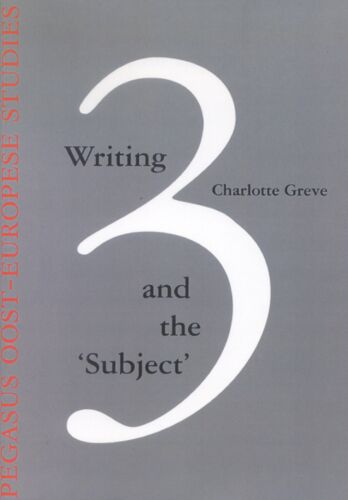POES 3: Writing and the 'Subject'
Greve, Charlotte
Pegasus, 344 blz., 2004, ISBN 9789061432920
POES is een serie studies op het gebied van de Oost-Europese taalkunde, letterkunde, cultuurkunde en geschiedenis onder redactie van prof. dr. Raymond Detrez, prof. dr. Wim Honselaar, prof. dr. Thomas Langerak en prof. dr. Willem Weststeijn.
This book was Dr. Charlotte Greve's Ph.D. study of the different kinds of image-text relations in the Russian avant-garde book, poetry, images and theoretical writings. The main focus is on the function of handwriting in the early Russian avant-garde (1912-1920) and in contemporary visual poetry (1960 to the present). She considers writing (in its material, physical form) as an ‘imagetext’ encompassing features and functions from both language and image. As an ‘imagetext’, writing is a form in which the ‘subject’ can visibly be presented. This is most evident in handwriting (both in its material form and as a concept through which writing must be understood). Extensively used by both the early Russian avant-garde and contemporary visual poets, handwriting is the prism through which writing as a physical, material trace is studied. The study discusses how the materiality of writing – the text as image – is generating meaning. In this, the concept of faktura – central to the early Russian avant-garde theories of art and poetry – encompasses the materiality of painting/mark and the composition of paint/marks on the canvas/page. It is, moreover, an index pointing to the painting/writing subject; it is a special deictic mode of painting/writing. The handwriting of the Russian avant-garde books, the poetics of handwriting, and the way handwriting is represented in poetry emphasize the way the subject (the speaking and the viewing/reading subject) manifests itself in the material mark on the page. The study shows how this indexical reference to a ‘subject’ is manipulated and used as a mask through which a writer/painter can perform a certain ‘subject’. Through analyses of the various levels on which the ‘subject’ is represented in the early as well as the contemporary avant-garde, it becomes clear that the ‘subject’ is an unstable category that can be exposed to manipulation and play. Handwriting is performing as a signature (as an index), but is at the same time similar to the signature of a subject (an icon) and a verbal construct (symbol). It is this complex relation between these instances that is enacted in the work of the early Russian avant-garde (as in the works of Aleksej Krucenych, Velimir Chlebnikov and Varvara Stepanova), and in contemporary visual poetry (as in the works of Ry Nikonova and Sergej Sigej). The works analysed present different cases of how this relation has been interpreted in the Russian avant-garde. Thus, there is a definite difference between the post-revolutionary (pre-constructivist) and the pre-revolutionary avant-garde approach. According to the first, a direct involvement in the political project of building a new society is an imperative, whereas the relation of the pre-revolutionary and contemporary avant-gardes to society is marked by an ironic subversion. These latter avant-gardes are remarkably similar, the most obvious difference being that the contemporary visual poet is aware of the semiotic implication of using the index as a sign of the ‘self’ and as a sign embedded in the social and cultural formation of authorship. These are used as signs of appropriation in a dialogic relation to previous avant-garde and non-avant-garde texts and images.
